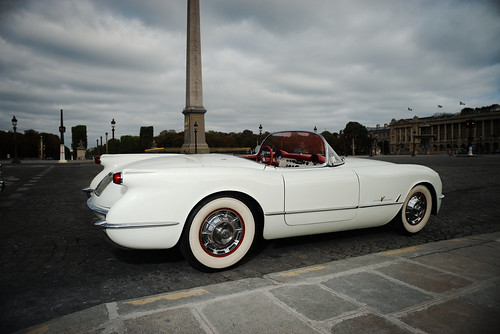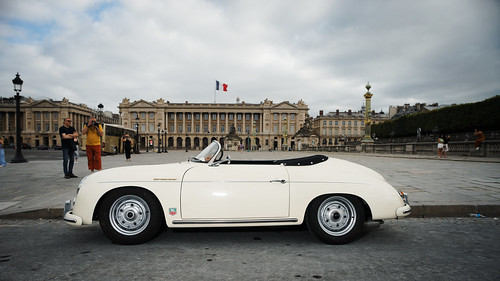With a big car event coming up, I was excited to try my hand at lighting up one of my favorite subjects. Nothing serious, of course. I'm retired and don't need nor want to impress anyone. No, this is just for the pleasure of pursuing a topic, understanding as much as I can, and to make an image or two that please me and only me.
I've been reading too many articles by David Hobby and Joe McNally. I seem to have caught the bug to shoot small flash. Here was yet Another Itch that needed to be Scratched. Photographically speaking.
To add another Itchy Spot to the Whole Plot, just the other day I read a very short article on how to photograph HotRods. The difference between what this article talked about (shooting in open shade) and what I would be doing is that I'd be working under partly cloudy to full sun conditions
I have three Cheap Chinese Flash units that I've picked up over the years. My calculations indicated I might _just_ be able to augment the power of the sun and make my subjects standout a bit from a slightly under-exposed background. That would be the goal.
My camera setups would be as follows -
- Sony A7 - set to full manual mode (stored settings as M1)
- Nikon Nikkor 24mm f/2.8 Ai
- Polarizing filter
My second camera would be -
- Sony A6000 - also set to full manual mode (again stored settings as M1)
- Nikon Micro-Nikkor 55mm f/3.5
- Lens Turbo II focal reducer
- Polarizing filter
It all seems a silly thing to in this Day and Age use manual focus Nikkors. Working with AF lenses and meter-coupled apertures would certainly be a faster, more accurate way to proceed, right? Well...
There were several competing ideas that swirled around my (sometimes empty) brain. One, as I've already said, was to use flash to brighten the subject relative to the background. Another idea was to see how wide I could get the aperture so as to blur the background. And the third swirling idea was to use a Polarizing filter to try and control reflections off shiny, painted, waxed surfaces.
In short, I would be trying to manage complexities in a discrete, one thing at a time, manner. It's sometimes important to keep an Aging Mind well exercised. Or so I'm told, but I can't remember who said it. I made a joke there. Did you get it?
I love the "idea" of my Nikkor lenses. Manual focus. Beautiful out of focus rendition when shot wide open. Manual aperture settings so I know exactly where I'm at. Of course, shooting in broad daylight would mean stopping lenses down and potentially sharpening up the entire scene with good depth of field.
Fortunately the (old hand calculated designs based on history and practical knowledge) Nikkors are by current standards (of computer ray traced designs solving for 11th order effects) brilliantly sharp stopped down.
I have modern AF Top Drawer lenses as well as many old Nikkors, and, frankly, from one click down on the aperture it's awfully difficult to tell any difference between them. So, with a few mental gymnastics I was able to convince myself to use the old Nikkors.
For the Cheap Chinese Flash setup, here's what would be used -
- Three Yongnuo YN560 flash units
- A cheap three flash mount bracket
- A cheap flash stand
- A RF/FM remote trigger system consisting of
- On-camera trigger
- Two remote flash hot-shoe'd receivers
All I needed to do when switching cameras from 24mm to 55mm and back again would be to slip the on-camera RF/FM trigger from one body to the other.
To make a complex situation more complex, I packed a 2-stop ND filter. This would allow me to open up the aperture, well, by 2 stops. If I did this right, I would be able to explore what happens to a scene when both sun-enhancing flash and narrower depth of fields are used in tandem. The effect might be interesting.
So how did my little experiment of shooting the all manual, maybe needlessly complex setup end up? Not 1/2 bad, actually. Let's have a look, shall we?
This was done under full sun (to my right). I put the flash units to the right as well, set their power to 1/4 and under-exposed the overall scene by 1/2 a stop. The depth of field is a little too good and the background is a bit distracting to my eyes. Though, the scene is well placed with the view of the large buildings in the background. I like the way the flashes did their jobs to bring the bike out of the mess. Even if it's just a little.
Shooting against the sun, setting the flash to my left, and putting the power at 1/4 or 1/2 on all three units I was able to blast the Holy Heck out of the Buick. The overall scene was under-exposed by, again, 1/2 stop. I like the effect. The people and the trees in the background at back-lit. So would the car be if I hadn't painted the car in light the way I did.
Three young ladies were being photographed by a local photographer. They were using the cars as backdrops. All three were "Miss" somethingorother. This lady was Miss Montmartre.
Had I not used fill-flash the scene would've been a lighting mess. The sun was throwing very strong shadows off everything and the Jaguar XK-SS would've disappeared into an inky black hole where no light could escape. I needed to flatten the contrast a little and to "open up" the Miss' far-side face if I could.
If you know me, you know I've owned several Jags in my life. They were my childhood pinnacle of automobilisme. They all had sexy lines and could push a gentleman smartly down the motorway at impressive speeds.
I'd read where the D-type race car had been lightly re-designed to take normal road-gear (bumpers, passenger seat, that kind of thing). Very few were made, though, before that portion of the Jaguars factory burnt. So it came as a huge surprise to see this car. Sure, the young lady is pretty. There's no doubt about that. But that Jag? Oh All Things That Are Holy this was glorious!!
I'm not sure if it's an original or a "continuation" version. Somehow I just can't see someone driving a many-millions of Euros car around Paris just for the hell of it. The insurance alone would cost a fortune. So I'm thinking this must be a very accurate reproduction (perhaps even done up by the factory?).
Early on in my little photo-session I balanced the overall scene exposure with the flash and let the flash simply fill the shadows. Looking at the cameras LCD convinced me I liked the gentle effect that simple flash-fill might bring.
For this Renault Alpine the sun was was over to my left (almost, but not quite shooting against it) and it cast a strong shadow to the right. So I placed the three flash setup to my right, set the power to 1/16 or 1/8 (rather low, whichever it was) and this is the image I came away with.
It's almost as if you can't see the effect of the flash. If I wasn't talking about it, would a viewer even notice? It's kind of interesting to think about in this way.
One more thing, look at the quality of the light. Having worked with flash for decades I might've guessed that a large light modifier had been used to "soften" up the light. But that's not the case at all. The three flash units were all bare and no light modifiers were used at all. This is just straight flash fill.
Lastly, we come to Coluche. How the great French humorist comes to be associated with this Ford Fairlane is beyond me. But there you have it. Coluche's name is attached to this car.
Ford made this line of Fairlanes back in the 1950's. By the late '50's Ford sold the factory, designs, tools, and everything to Simca. Simca continued to produce these cars for several years after. I have to look at the badges to know which side of the Ford Sale any particular car comes from.
For this image the full sun was over left shoulder. You can see the flash-filled shadow from the sun on the ground to the right of the car. The overall exposure was set to -1/2EV to knock down the sky a bit and to make the people darker.
I set the three flashes power to full *pop* and set the stand to my right. If you look at the cars fin in the center of the frame, you can just make out the shadow that the flash threw off the fin and onto the rear trunk.
To me this image really "pops." It's filled with colors and shapes. It "feels" interesting. It fully expresses what I wanted to capture about these old cars that participate in le traversee de Paris. All it took was three RF/FM controlled flash mounted on a cheap flash stand.










